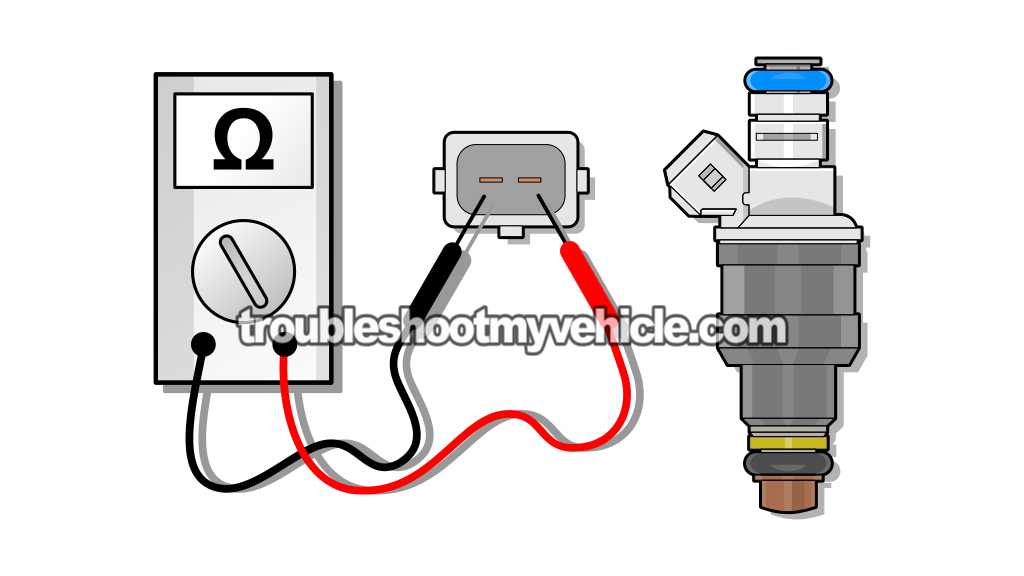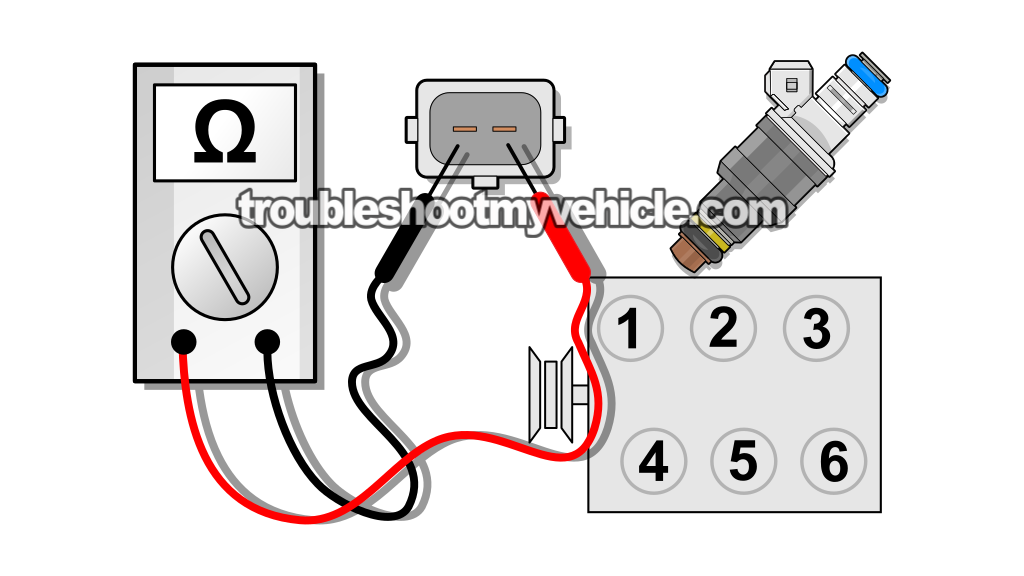
Testing the fuel injectors on the 1991-1996 4.0L Ford Explorer and Aerostar can be quite a challenge. Why? Because three of them are under the intake manifold plenum.
Also, when they fail, they usually don't leave a specific fuel injector diagnostic trouble code (DTC). Generally the PCM will only register a misfire code (P0300, P0301, P0302, P0303, P0304, P0305, P0306) or nothing at all on the OBD II equipped Explorer.
Although fuel injectors don't go bad very often, they also don't last for ever and this little tutorial will show you how to test them with a multimeter. No scan tool required.
NOTE: You can find the 1990-1996 4.0L Ford Ranger (Mazda B4000) fuel injector test here:
- Fuel Injector Resistance Test (1990-1996 4.0L Ford Ranger And Mazda B4000) (at: easyautodiagnostics.com).
Contents of this tutorial:
APPLIES TO: This tutorial applies to the following vehicles:
- 4.0L V6 Ford Aerostar: 1990, 1991, 1992, 1993, 1994, 1995, 1996.
- 4.0L V6 Ford Explorer: 1991, 1992, 1993, 1994, 1995, 1996.
You can find the 1997-2001 Ford Explorer, Aerostar, and Mercury Mountaineer fuel injector test here:
Fuel Injector Resistance Specifications
| Aerostar | ||
|---|---|---|
| Year | Engine | Ohms |
| 1990-1995 | 4.0L | 13-16 Ohms |
| 1996 | 4.0L | 11-18 Ohms |
| Explorer | ||
|---|---|---|
| Year | Engine | Ohms |
| 1991-1992 | 4.0L | 13-16 Ohms |
| 1993-1996 | 4.0L | 11-18 Ohms |
The Fuel Injector Resistance Test

This section outlines the fuel injector resistance test. If you haven't narrowed down the dead cylinder yet, then please take a look at this section:
You'll need a multimeter to test the fuel injector resistance. If you don't have one, check out my recommendation here: Tekpower TP8268 AC/DC Auto/Manual Range Digital Multimeter (Amazon affiliate link).
These are the test steps:
- 1
Removing the intake manifold's plenum.
NOTE: Place clean rags in the open intake runners.
See this section: Important Precautions When Removing The Intake Manifold Plenum. - 2
Disconnect all six fuel injectors from their electrical connectors.
- 3
Place your multimeter in Ohms mode.
- 4
Probe the metal male spade terminals inside the fuel injector with the multimeter test leads.
- 5
Your multimeter should register the indicated resistance specification.
NOTE: You can find the resistance specification here: Fuel Injector Resistance Specifications. - 6
Repeat test steps on the remaining fuel injectors.
Let's interpret your test results:
CASE 1: All resistance values were within specification. This is the correct and expected test result and it tells you that the fuel injectors do not have an internal short-circuit or open-circuit problem.
CASE 2: One of the fuel injector resistance values is not within specification. Retest that one fuel injector once again.
If the fuel injector registers the same Ohms value as before, the fuel injector is bad and needs replacement.
Fuel Injector Troubleshooting Strategy
As mentioned at the beginning of this tutorial, three fuel injectors are located under the intake manifold plenum. Testing these fuel injectors requires removing the plenum (to access them).
Fortunately, there is a troubleshooting strategy that may help you avoid removing the plenum. Not only that, it'll help you get to the bottom of the misfire or rough idle issue without wasting time and money.
The following diagnostic strategy has helped me determine which fuel injector is bad and more importantly, if it's located under the plenum. So I'm confident it'll help you too.
PART 1: Identify The Dead Cylinder.
Identifying the 'dead' cylinder is the critical first step of this fuel injector diagnostic strategy.
You can pinpoint the 'dead' cylinder by performing a cylinder balance test.
The biggest benefit of the cylinder balance test is that it'll help determine if the 'dead' cylinder's fuel injector is located underneath the intake manifold plenum.
NOTE: Even if your Ford Explorer (Aerostar) is OBD II equipped and you've got a cylinder misfire diagnostic trouble code, do the cylinder balance test to make sure you've identified the correct cylinder.
PART 2: Make Sure The Dead Cylinder Is Getting Spark.
After you've identified the 'dead' cylinder, your next step is to make sure its spark plug wire delivers spark to its spark plug.
You must perform the spark test with a dedicated spark tester. Any spark test method that does not involve a spark tester will only have you chasing ghosts (and wasting time and money).
You'll also need to:
- Check the spark plug for any apparent damage.
- Check the spark plug for excessive wear.
- Check the spark plug electrodes are not blocked with carbon.
- Check the spark plug's air gap.
- Check the spark plug, and the spark plug wire does not have carbon tracks.
- Check the spark plug wire isn't missing the metal connector that connects to the spark plug.
If the 'dead' cylinder isn't getting spark, you've found the source of the misfire (rough idle), you don't need to test the fuel injectors.
If the 'dead' cylinder is getting spark and the spark plug and spark plug wire are OK, the next step is checking the 'dead' cylinder's compression.
PART 3: Make Sure The Dead Cylinder Has Compression.
If the ignition system is not causing the 'dead' cylinder issue, your next step is to make sure the 'dead' cylinder produces enough compression to start and complete the air/fuel mixture's combustion process.
Now, you don't need to test all six cylinders. But for the accuracy of your diagnostic, you should test all six.
You can find the compression test explained in detail here:
- How To Test Engine Compression (1991-2010 4.0L V6 Ford Explorer, Aerostar, And Mercury Mountaineer).
If the 'dead' cylinder's compression value is 15% lower than the highest compression reading your compression test has given you, then you've found the cause of the misfire (rough idle) issue, and you don't need to test the fuel injectors.
If the 'dead' cylinder's compression value is within a normal range, your next step is to test the fuel injectors.
PART 4: Test The Fuel Injectors.
If you've reached this point, you have:
- Confirmed the 'dead' cylinder is getting spark.
- Confirmed the 'dead' cylinder's compression is OK.
If the 'dead' cylinder's fuel injector is underneath the intake manifold plenum, you can now make plans to remove it and resistance test the fuel injector.
Important Precautions When Removing The Intake Manifold Plenum
If you've found a fuel injector under the intake manifold's plenum that needs replacement, keep in mind the following suggestions:
- Take care that no foreign object, like a bolt, a nut, or any metal piece/part, falls into the open manifold port runners.
- After removing the plenum, cover the open intake runners with clean rags (shop towels). These towels will keep things from falling into the open runners.
- As you're removing bolts, nuts, etc., from the intake plenum, place them in a container and away from the engine compartment.
If anything falls into the open intake runners, without you knowing, and you start the engine, you're going to be in a big world of hurt!
The only way to remove what fell in, after you've put everything back together is to remove the cylinder head(s). So be alert and be careful.
Don't worry. The plenum can be removed without complications or unhappy endings by simply following some precautions.
One last thing, when you reinstall the plenum, use new gaskets. Install these gaskets without any sealant, like RTV silicone. Using a sealant like RTV silicone may cause vacuum leaks down the road, and you're back to square one (removing the plenum).
More 4.0L Ford Explorer (Aerostar) Tutorials
You can find a complete list of 4.0L Ford Explorer (Aerostar) tutorials in this index:
Here's a sample of the tutorials you'll find in the index:
- How To Test For A Blown Head Gasket (1991-2010 4.0L V6 Ford Explorer, Aerostar, And Mercury Mountaineer).
- How To Test The Fuel Pump (1993-2000 4.0L V6 Ford Explorer, Aerostar, And Mercury Mountaineer).
- How To Test Engine Compression (1991-2010 4.0L Ford Explorer, Aerostar, And Mercury Mountaineer).

If this info saved the day, buy me a beer!


